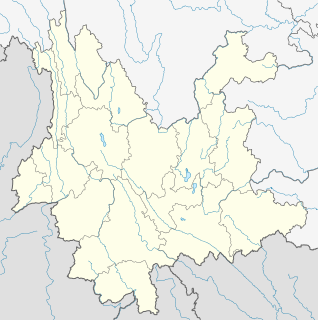
The Gelao people are an ethnic group of China and Vietnam. They form one of the 56 ethnic groups officially recognized by the People's Republic of China. However, many Gelao are also variously classified as Yi, Miao, and Zhuang by the Chinese government.
Gelao is a dialect cluster of Kra languages in the Kra–Dai language family. It is spoken by the Gelao people in southern China and northern Vietnam. Despite an ethnic population of 580,000, only a few thousand still speak Gelao. Estimates run from 3,000 in China by Li in 1999, of which 500 are monolinguals, to 7,900 by Edmondson in 2008. Edmondson (2002) estimates that the three Gelao varieties of Vietnam have only about 350 speakers altogether.

Wenshan Zhuang and Miao Autonomous Prefecture is an autonomous prefecture in southeastern Yunnan province, People's Republic of China, and the easternmost prefecture-level division of the province. It borders Baise, Guangxi to the east, Vietnam's Hà Giang Province to the south for 438 kilometres (272 mi), Honghe Hani and Yi Autonomous Prefecture to the west, and Qujing to the north.

Bijie is a prefecture-level city in northwestern Guizhou Province, China, bordering Sichuan to the north and Yunnan to the west.

Xundian Hui and Yi Autonomous County is an autonomous county in the northeast-central part of Yunnan province, China. It is under the administration of the prefecture-level city of Kunming, the provincial capital.

Lufeng County is located in Chuxiong Yi Autonomous Prefecture, Yunnan province, China.

Weining Yi Hui and Miao Autonomous County is a county of Guizhou, China. It is under the administration of the prefecture-level city of Bijie.
Nasu, or Nasu proper, is a Loloish language spoken by a quarter million Yi people of China. Nasu proper and Wusa Nasu are two of six Yi languages recognized by the government of China. Unlike most written Yi languages, Nasu proper uses the Pollard (Miao) script. A distinct form of the Yi script was traditionally used for Wusa, though few can still read it.
The West Hmongic languages, also known as Chuanqiandian Miao and Western Miao, is the major branch of the Hmongic languages of China and Southeast Asia.
Caijia is an endangered Sino-Tibetan language spoken in an area centred on Bijie, in the west of the Chinese province of Guizhou. It was discovered in the 2000s. It has been described by different authors as a relative of Bai or an early branching from Old Chinese. The autonym is.

The Longjia are an unofficially recognized ethnic group of western Guizhou province, China. They are officially classified as Bai by the Chinese government.
The Greater Bai or simply Bai languages are a group of Sino-Tibetan languages proposed by Zhengzhang (2010), who argues that Bai and Caijia are sister languages. In contrast, Sagart (2011) argues that Caijia and the Waxiang language of northwestern Hunan constitute an early branching from Old Chinese. Additionally, Longjia and Luren are two extinct languages of western Guizhou closely related to Caijia.
Longjia is a Sino-Tibetan language of Guizhou, China related to Caijia and Luren. Longjia may already be extinct.
Lu, or Luren (卢人), is an extinct Sino-Tibetan language of Guizhou, China. The Luren language may have been extinct since the 1960s.
Luoji is a moribund Loloish language of Weining County, Guizhou, China that is spoken by the Qixingmin people. There are a few semi-fluent elderly speakers in Shejie Village 蛇街村, Yangjie Town 羊街镇, Weining County, with no fluent speakers remaining.










